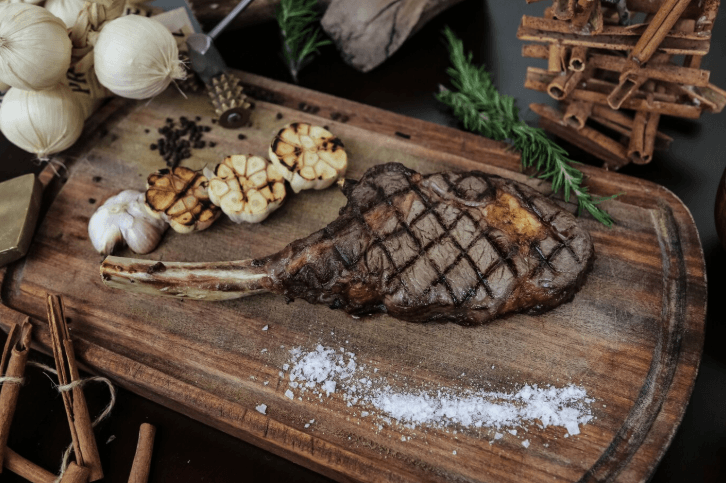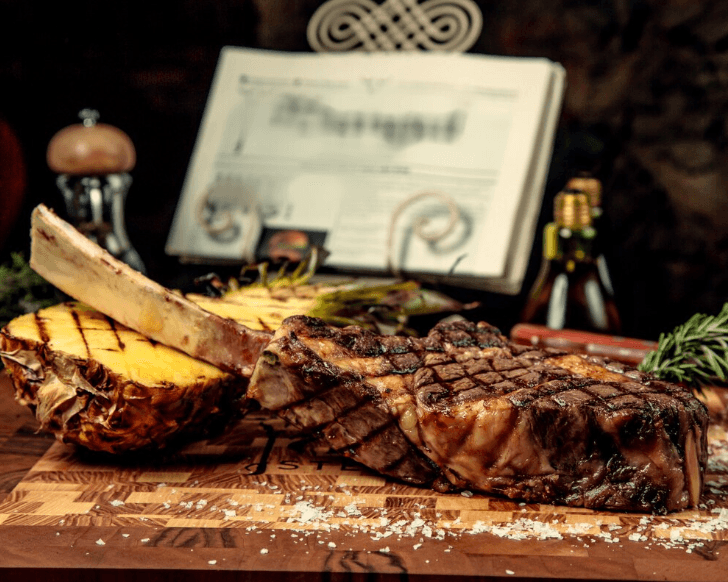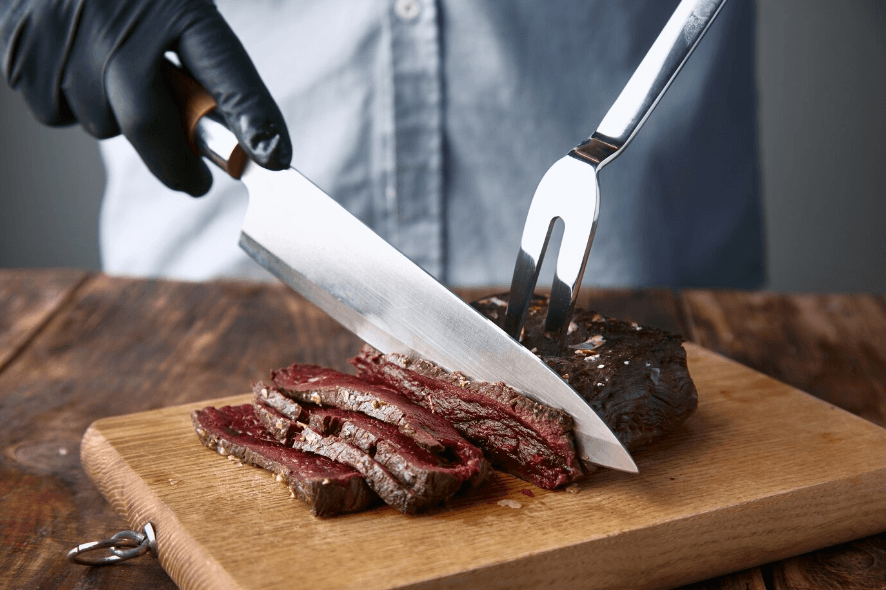Cowboy steak is more than just a cut of meat; it’s a bold culinary statement. Known for its size, flavor, and premium quality, this bone-in ribeye variation has captured the hearts (and wallets) of steak lovers everywhere. But have you ever wondered why it comes with such a hefty price tag? In this article, we’ll dive into the specifics of what makes cowboy steak so special and explore the factors driving its cost. From marbling to market demand, we’ll leave no steak stone unturned!
What is a Cowboy Steak?
What Makes a Cowboy Steak Unique?
Cowboy steak is not your average cut of meat. This premium bone-in ribeye stands out with its impressive size typically 18-32 ounces and thick cut, which provides an unmatched eating experience. Unlike boneless ribeye, the cowboy steak includes a short rib bone, enhancing both its appearance and cooking properties. This bone acts as a heat conductor during cooking, keeping the surrounding meat moist and flavorful.
Its marbling, the intricate fat lines running through the meat, plays a starring role. The result? A tender, juicy bite with a rich, buttery flavor. Cowboy steak’s robust size and luxurious texture make it a favorite for grilling enthusiasts and steakhouse connoisseurs. Read More
Origins and Popularity of Cowboy Steak
The history of the cowboy steak is deeply rooted in American ranching culture. Its name evokes imagery of rugged cowboys enjoying hearty meals after long days on the trail. This nostalgic appeal, combined with its extraordinary flavor, has elevated its status in steakhouses worldwide.
Its rise in popularity owes much to steak enthusiasts who value its bold presentation and unique characteristics. The cowboy steak doesn’t just feed your appetite; it creates an unforgettable dining experience.
Factors Behind the High Cost
Premium Quality and Marbling
One of the main reasons cowboy steak carries a premium price tag is its exceptional quality. This cut is often sourced from USDA Prime or Choice beef, the highest grading tiers based on marbling and tenderness. Marbling refers to the fat interwoven within the muscle, which melts during cooking, infusing the meat with unparalleled flavor.
Steak lovers prize this luxurious fat distribution, and achieving it requires careful breeding and feeding practices. Cattle raised specifically for marbled cuts like cowboy steak are fed specialized diets, often including grain, to enhance the marbling process. This meticulous care not only ensures quality but also adds to the overall cost.
Size and Weight of the Cut
Cowboy steak is renowned for its size often weighing in at over 2 pounds. This impressive cut is thicker than most steaks, requiring more from the butcher and the cow itself. Larger steaks mean fewer cuts per animal, making cowboy steak a rarer option compared to smaller, more common steaks like sirloin.
Its substantial size also means a single steak can easily serve two people, making it a standout choice for shared meals or special occasions. However, this size contributes directly to its higher price, as it’s a significant portion of the cow’s premium rib section.
Limited Yield Per Cow
Another factor affecting cost is the limited yield of cowboy steaks per cow. Each cow only provides a small portion of ribeye cuts suitable for cowboy steak, making them a rare delicacy. Since demand often outpaces supply, prices climb even higher.
Specialized Processing Techniques
Preparing a bone-in cowboy steak requires expert butchery. The bone must be cleaned and trimmed meticulously to achieve the signature look that makes cowboy steak so appealing. This extra labor, combined with the skill required to maintain the cut’s integrity, adds to the overall expense.
Supply Chain Costs
Transporting and storing such a large, bone-in cut also incurs additional costs. Unlike smaller steaks, cowboy steak demands specific packaging and temperature-controlled environments to maintain its quality. These logistical considerations further drive up its price.
Bone-in Appeal
The short rib bone that defines cowboy steak isn’t just for aesthetics. It enhances the steak’s flavor and helps retain moisture during cooking. This unique feature makes cowboy steak a standout option for grilling, where the bone acts as an insulator. However, the bone adds weight, which increases the cost per pound without being edible.
Demand vs. Supply Dynamics

The Role of Market Demand in Price
The popularity of cowboy steak is a driving factor behind its high cost. As dining preferences lean toward premium, bone-in cuts with a rich flavor profile, cowboy steak often sits at the top of the menu in high-end steakhouses. This demand creates an environment where producers can charge more due to the steak’s reputation as a luxury item.
Beyond steakhouses, grilling enthusiasts and home chefs seeking a unique, indulgent meal have also contributed to the rising demand. The cowboy steak’s appeal isn’t just about taste it’s about making a statement. Whether served at a backyard barbecue or a celebratory dinner, its presentation is unforgettable, and many are willing to pay a premium for the experience.
Export and International Demand
As global markets continue to appreciate American beef, exports have surged. High-quality cuts like cowboy steak are especially popular in countries with a growing appetite for luxury dining. Exporting premium beef increases its scarcity in local markets, leading to higher prices domestically.
Additionally, some regions, such as Asia and the Middle East, are known for their preference for well-marbled, large cuts of beef. This international demand adds significant pressure on the supply chain, further driving up costs.
Seasonal and Regional Factors
The price of cowboy steak can also fluctuate based on the time of year and geographic location. During grilling season typically spring and summer demand skyrockets as consumers fire up their barbecues. This surge often leads to temporary price increases.
Regionally, areas with limited access to high-quality beef or fewer local butchers offering specialized cuts may experience higher prices due to transportation and availability challenges.
The Impact of Rearing and Feeding Practices
Cattle Breeding for Premium Cuts
Producing a cowboy steak requires meticulous care, beginning with cattle selection. Ranchers often use high-quality breeds like Angus or Wagyu, known for their marbling and tenderness. These breeds require specialized care, including controlled environments and premium diets, to ensure top-notch results.
This care includes genetics-focused breeding programs, where ranchers selectively breed cattle to enhance traits like marbling, flavor, and overall quality. Such programs demand time, expertise, and resources, all of which contribute to the final price of cowboy steak.
Specialized Feeding Programs
The feeding process also plays a significant role in the steak’s cost. Grain-fed cattle, which dominate the cowboy steak market, undergo carefully monitored diets to optimize marbling. This process can take several months, significantly increasing production costs compared to grass-fed alternatives.
In addition to grain, some cattle diets may include supplements designed to improve fat distribution and flavor. These additional inputs are not cheap but are necessary to achieve the luxurious texture and flavor steak enthusiasts expect from cowboy steak.
Environmental and Ethical Practices
In recent years, there has been a growing emphasis on sustainable and ethical farming practices. Consumers are increasingly willing to pay more for meat from farms that prioritize animal welfare and environmentally friendly methods. However, these practices require additional investment, from pasture management to reducing the carbon footprint of operations, which adds to the price.
Time Investment in Raising Cattle
Unlike other livestock, cattle bred for premium cuts like cowboy steak require longer rearing periods to reach optimal size and marbling. This extended timeline ties up resources, including land, feed, and labor, making the overall production process more expensive.
Why Bone-In Cuts Command Higher Prices

Flavor Enhancement from the Bone
One reason cowboy steak is so prized—and costly—is its bone-in feature. The bone contributes to the steak’s unique flavor profile by acting as a heat conductor during cooking, ensuring even heat distribution throughout the meat. This process, often called “bone-flavoring,” adds a rich depth to the steak’s taste, making it more desirable among steak connoisseurs.
Additionally, the bone helps retain moisture, preventing the steak from drying out during cooking. This results in a juicier, more tender bite that’s hard to replicate with boneless cuts.
Visual and Culinary Appeal
Beyond flavor, the bone’s dramatic presentation makes cowboy steak a show-stopper on the plate. Its rustic, hearty appearance aligns with its name, evoking images of old Western feasts. For many, the cowboy steak isn’t just food it’s an experience, and that aesthetic value is built into the price.
Higher Weight Without Edibility
The inclusion of the bone increases the steak’s overall weight, which raises its price per pound. While the bone enhances flavor and presentation, it’s not edible, meaning consumers pay for a portion of the steak they can’t eat.
Cooking Complexity
Preparing a bone-in steak like cowboy steak requires a bit more finesse, both at the butcher shop and in the kitchen. The bone can make even cooking tricky, as it acts as a barrier to heat. For restaurants and home cooks, this adds an extra layer of complexity, often justifying the higher cost for the experience and expertise required.
Understanding USDA Beef Grades” USDA Prime Beef – Explains beef grading and its impact on price.
Market Trends and Consumer Preferences
The Appeal of Premium Steaks
Consumer demand for luxurious, high-quality dining experiences is at an all-time high, and cowboy steak fits perfectly into this trend. Whether for a special occasion or a statement meal, its premium nature appeals to those who seek indulgence. Steakhouses often feature cowboy steak as a menu highlight, further solidifying its status as a luxurious choice.
Social Media and Culinary Culture
Platforms like Instagram and TikTok have played a significant role in popularizing visually striking dishes like cowboy steak. Its impressive size, bone-in presentation, and perfect sear make it an eye-catching centerpiece that food enthusiasts love to showcase.
This cultural fascination with “Instagram-worthy” meals has contributed to a surge in demand, allowing suppliers to maintain premium pricing. Additionally, cooking shows and celebrity chefs frequently highlight cowboy steak, amplifying its reputation as an elite cut of meat.
Emerging Food Trends
The rise of food tourism and experiential dining has also boosted the appeal of cowboy steak. Consumers are increasingly drawn to meals that combine flavor with presentation, and cowboy steak’s unique aesthetic makes it a go-to choice for this audience.
Moreover, as grilling culture grows worldwide, enthusiasts often look for standout cuts to elevate their backyard barbecues, making cowboy steak a prized addition to their repertoire.
The Cost of Presentation and Exclusivity

Packaging and Distribution for Premium Cuts
The journey of a cowboy steak from the butcher to your plate involves careful handling to preserve its quality. Unlike smaller, more common cuts, cowboy steak requires special packaging that ensures freshness and aesthetic appeal. Vacuum-sealing techniques and temperature-controlled transportation systems add to the overall cost.
Retailers also invest in high-quality presentation to market the steak effectively. From butcher shop displays to restaurant menus, cowboy steak is often showcased as a premium option, justifying its exclusivity and price tag.
Exclusive Dining Experiences
Cowboy steak isn’t just about the meat; it’s about the experience. High-end steakhouses often incorporate specialized preparation techniques, from dry-aging the steak to using custom grills. These methods enhance flavor but require significant investment in equipment, time, and expertise, which are reflected in the price.
Scarcity Drives Value
Adding to its exclusivity is the scarcity of cowboy steak, both in terms of availability per cow and its appeal as a luxury item. Scarcity creates a sense of value, making consumers willing to pay a premium. The combination of rarity, exceptional taste, and aesthetic presentation makes cowboy steak a sought-after delicacy.
Conclusion
In summary, the high cost of cowboy steak reflects the combination of factors that make it a standout cut of beef. From the meticulous rearing and feeding practices to the premium presentation and exclusivity, every step in its production adds to its value. The influence of market trends, such as consumer demand for high-quality and visually appealing dishes, further cements its status as a luxury item.
Moreover, cowboy steak is not just a meal it’s an experience. Whether you’re indulging at a fine-dining steakhouse or mastering its preparation at home, the robust flavor, tenderness, and dramatic bone-in presentation create a culinary moment worth savoring. For those willing to pay a little extra, the cowboy steak offers an indulgence that truly lives up to its price.
If you’re considering splurging on a cowboy steak, keep in mind the journey behind this premium cut. It’s a perfect example of how craftsmanship, quality, and consumer preferences come together to create something exceptional. Bon appétit!
FAQs: Why is Cowboy Steak So Expensive?
1. What makes cowboy steak different from other steak cuts?
Cowboy steak is a bone-in ribeye cut, prized for its exceptional marbling, robust flavor, and dramatic presentation. The inclusion of the bone not only enhances flavor but also adds to its aesthetic appeal, making it unique compared to other boneless steak cuts.
2. Is cowboy steak worth the high price?
For steak enthusiasts, cowboy steak offers a unique combination of flavor, tenderness, and presentation that justifies its cost. Its large size and bone-in structure make it ideal for special occasions or gourmet experiences, adding value beyond just the meat itself.
3. How much does a cowboy steak typically cost?
The price of a cowboy steak can vary widely based on factors like location, butcher, and quality of the beef. On average, it ranges between $20 to $50 per pound in retail settings, while restaurants may charge upwards of $100 for a single serving.
4. Why is the bone in cowboy steak left intact?
The bone contributes to flavor by acting as a heat conductor, ensuring even cooking and enhancing the steak’s juiciness. It also adds to the visual appeal, giving cowboy steak its signature rustic look that many diners love.
5. How can I cook a cowboy steak to maximize its value?
Cooking a cowboy steak properly is essential to make the most of its premium price. Opt for methods like reverse searing or grilling to achieve a perfect crust while retaining its juicy interior. Letting the steak rest after cooking also enhances its flavor and tenderness.
6. Are there more affordable alternatives to cowboy steak?
If you’re looking for a similar flavor and texture without the premium price, consider cuts like bone-in ribeye or porterhouse. While they may lack the dramatic presentation of cowboy steak, they offer comparable taste and tenderness.
